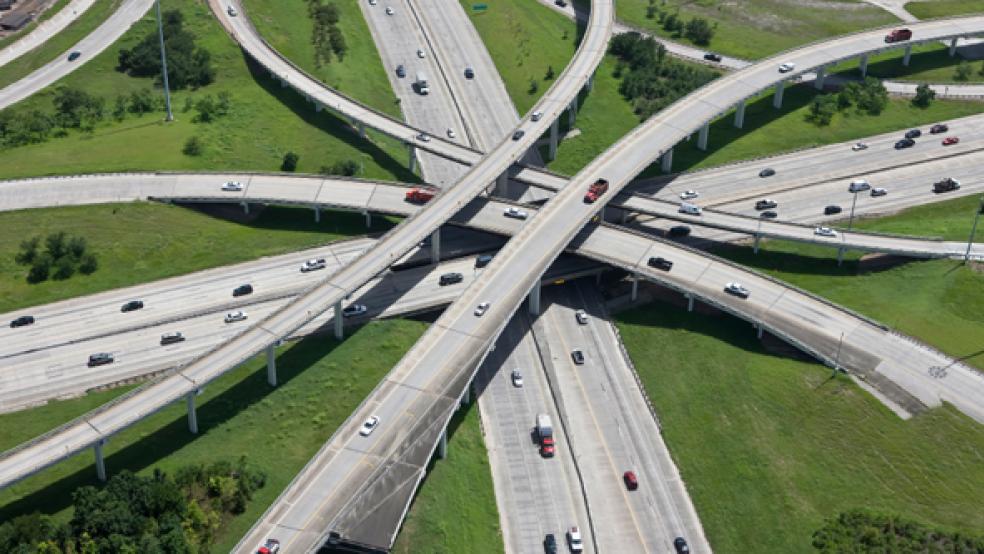Congress is once again using smoke and mirrors to avoid raising a spending limit. This time, the accounting gimmicks are to fund a short-term extension of the federal transportation program and a longer-term version.
As members rushed to clear out of town for a long August recess, the House voted 385 to 34 on Wednesday to extend spending authority for highway, bridge and other infrastructure construction through Oct. 29 and replenish the near-bankrupt Highway Trust Fund with an $8 billion infusion from the general fund. The Senate is now expected to take up the House-passed bill today, ahead of a midnight Friday deadline, when money will run out to finance state and local infrastructure programs throughout the country, as well as a six-year proposal.
Related: 5 Gimmicks in the GOP’s ‘Gimmick-Free’ Budget
Rep. Bill Shuster (R-PA), the chair of the House Transportation and Infrastructure Committee, said yesterday that the short-term bill would buy time for House and Senate leaders to break a deadlock and come up with a new multi-year national transportation program later this fall.
Meanwhile, he said, “This legislation is fully paid for and will not add to the nation’s debt.”
But rather than carving out spending from other programs or raising taxes to offset the $8 billion measure, the Congress will simply dip into the general fund. As for the Senate’s long-term version costing $275 billion over six year, lawmakers have dreamed up a potpourri of budget gimmicks and creative policy changes to foot the bill.
“They’re essentially scraping the bottom of the barrel in terms of pay-fors,” said Stan Collender, a Qorvis MSLGROUP executive and expert on the federal budget. “But the more important thing is that these things only work on paper. It’s not clear they actually work.”
Related: What Balanced Budget? GOP Pushes a 'Spend More' Blueprint
The Senate experimented with a number of budget tricks for the highway bill in recent weeks before settling on a dozen or so key provisions in concert with Senate leaders.
Some of them are relatively minor, such as dipping into a “Sportfish Restoration and Boating” trust fund and a “Leaking Underground Storage Tank Trust Fund” that was created to deal with petroleum releases from federally regulated underground storage tanks. Another would require the deposit of civil penalties related to federal motor vehicle safety violations in the Highway Trust Fund instead of the Treasury’s general fund.
Others that purportedly will generate billions of dollars involve changes to current Internal Revenue Service laws and regulations. A little more than $1 billion could be raised in the coming decade by requiring mortgage lenders to reduce the amount of misinformation provided by borrowers on their mortgage applications. Lawmakers insist that an additional $1.5 billion can be generated over the coming decade by changing the policy governing the valuation of inherited property for tax purposes.
Architects of the long-term term highway legislation insist that the government could raise an additional $2.4 billion over 10 years by requiring the IRS to utilize private debt collection agencies to help facilitate the collection of taxes owed the government. That plan has been kicking around for a while. Last year, Sen. Charles Schumer (D-NY) offered a proposal that he claimed would raise an estimated $4.8 billion in new tax revenue over a decade by requiring the IRS to hire private debt collectors. New York at the time was reportedly home to two of four firms that would likely get the work. That plan was tabled until now.
Related: Congress Uses Accounting Gimmicks to Fund Highway Bill
By far the biggest pay-for -- estimated to generate $16.3 billion over 10 years-- comes from adjusting the rate of dividend payments that Federal Reserve Banks pay to the member banks who own shares in them. The proposal suggests slashing the current dividend rate from 6 percent to 1.5 percent for large banks with over $1 billion in consolidated assets. That is something that would annoy bankers, but probably not to the point of major protest except perhaps from the very largest institutions.
Banks that belong to the Federal Reserve System are required to buy stock in their regional Federal Reserve Bank proportional to their capital. In exchange, the Fed is statutorily required to pay an annual dividend of 6 percent to its shareholders. The fact that banks hold stock in the Fed theoretically gives them a claim on their individual Reserve Bank’s profits.
However, this is not a traditional shareholder-share issuer arrangement. In reality, the six percent payout on the shares amounts to a small fraction of the Reserve Banks’ profits. In recent years, Banks were paid around $1.6 billion in total dividends, while the Fed’s collective profit – transferred to the U.S. Treasury – was nearly $90 billion.
The Fiscal Times’ Rob Garver contributed to this report





